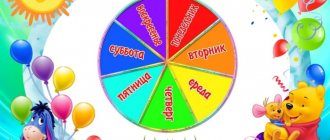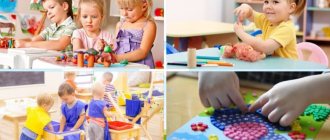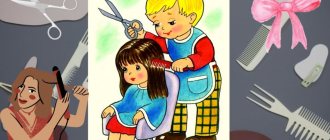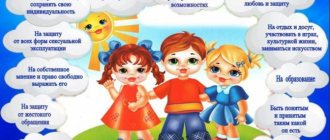Didactic games on FEMP in the younger group
This category presents games for preschoolers aged 3–4 years, teaching grouping, comparison and correlation of objects by size and shape, perception of distance and direction of movement, expanding the understanding of geometric shapes, forming the skill of planar and spatial orientation. Children should develop quantitative concepts and an understanding of the equality of objects.
Regardless of how the FEMP didactic games are divided into groups, it is important to develop fine motor skills and speech skills, and to cultivate perseverance and hard work in children.
Match the item to the figure
Geometric shapes are laid out on one table, small objects on the other. The teacher points to one of the presented geometric shapes. The player’s task is to find an object on another table that is similar in outline to the demonstrated figure. For example, the teacher pointed to a circle, the child takes a round cosmetic mirror from the table.
Geometric Lotto
To play, you need cut out cardboard images of basic geometric shapes, as well as lotto cards depicting these same shapes. The teacher distributes cards to the students and asks them to put the cut out figures on the lotto so that they cover the corresponding geometric images. Laying out the pieces, each player traces them with his finger and names them out loud.
Assistants
The teacher fills buckets with different types of substances: sand, small pebbles, scraps of paper, grain, etc. Asks the students to use a spatula to pour the contents into empty buckets. Children, while completing the task, tell what is more difficult for them to pour, what is easier, what substance weighs more.
Beautiful scarf
To play, you need to cut out images of autumn leaves of different sizes, colors and shapes from colored paper. The teacher hands out handkerchiefs to the children and takes one for himself. Then he suggests that they work together to decorate the scarves. The teacher decorates his scarf, the children repeat the pattern after him, while saying how many leaves of a certain color and shape are laid out in each corner of the scarf, in which direction they are laid, whether the number of leaves is equal or not, how to equalize them.
Next, each child decorates the scarf in his own way, telling which leaves he used and in what quantity.
Two tracks
The teacher lays out two tapes on a horizontal surface: one is noticeably wider than the other. Next he distributes toy cars to the children. The task is to drive along the paths. While completing the task, preschoolers conclude that only one car can drive along a narrow track, but two cars can drive along a wide track at the same time.
Race crawling
Children play in pairs and stand at one end of the playroom. At the other end, the teacher places two objects on the floor. One item should be closer to the children. At the signal, players lie down on their stomachs on the floor and begin to crawl towards their goals. One player gets to the item faster. The teacher asks the other students why this happened. Children must infer that because of the different distances between players and objects.
Treats for bunnies
The teacher places toy bunnies on the table and asks the children to treat them with carrots. As the game progresses, the teacher asks questions to which the players must answer clearly:
- “How many bunnies came to visit us?” - "A lot of";
- “How many carrots?” - "A lot of";
- “Are there more or fewer carrots than bunnies?” - “Equally.”
Paths
The teacher tells the students that the bunny and the badger live in cozy holes, but there are no paths to the house. Next, he shows the children pictures depicting holes at different distances from the animals. The players' task is to draw paths with a pencil to the holes of the bunny and badger, and at the same time say which path is long and which is short.
Similar pictures can be made for other animals.
Didactic games for mathematical development
The presented card index of didactic games in mathematics is recommended for preschool teachers and parents. During classes, preschoolers become familiar with counting, learn to work with numbers and geometric shapes, compare, contrast, and list.
Objectives of the games presented in the catalog:
- gaining skill in using numbers;
- improving the ability to count and distribute numerical values;
- familiarity with numerical and conceptual designations of time, days, months;
- development of spatial and planar orientation, the ability to determine and explain the location of objects relative to each other;
- expansion of ideas about geometric shapes;
- development of memory, ability to think logically, reason, analyze, make assumptions, sum up, concentrate attention;
- development of creative thinking and imagination.
Didactic games on FEMP in the middle group
We present games for the formation of elementary mathematical concepts in preschoolers 4–5 years old. Children learn to count, operate with spatial and temporal representations, analyze, compose, compare, organize objects, and use appropriate lexical concepts. Preschoolers develop color perception and an understanding of sequence. Games develop memory, speech skills, concentration, and the ability to think logically.
Geometry
Children receive 10–20 counting sticks and 2 laces 20–30 cm long. These devices are used to create various flat figures. The sticks are used to make shapes with angles: squares, rectangles, triangles of different sizes. And the laces are made into ovals and circles.
Beads for matryoshka
The teacher prepares a cord and attaches small images of geometric figures in a certain order to it from the right edge. Next he asks the children to continue making beautiful beads for the nesting doll. Players take geometric figures from the box and stick them on a string in the correct order.
Harvest
To play, you need two different-sized baskets and images of vegetables and fruits of different sizes. The game task is to sort the harvest into baskets: put large fruits in the larger one, and small ones in the smaller one. During the game, children tell what size baskets they see in front of them, what vegetables and fruits they put in them.
Tails
To play you need toy animals: elephant, bunny, monkey, fox, bear cub. Animals cannot figure out whose tail is longer. Children must resolve the dispute. They measure the tails by placing them next to each other and compare them using the appropriate adjectives: long, short, big, small.
Right wrong
The teacher distributes two circles to the students: red and green. Then he pronounces phrases on the theme of the seasons of the year and time of day. Children raise a red circle if the phrase is incorrect, for example, “after autumn came spring.” Or a green circle if the phrase is correct, for example, “the boy does exercises in the morning.”
Find the item
The teacher hides an object in the playroom, and the child must find it, following the clues. The teacher says, for example: “Three steps to the right, one forward, bend over, look under the table.” The child tries to do everything he hears.
Circle and oval
The teacher attaches several ovals and circles of different sizes and colors to the magnetic board. He asks how the figures differ and how they are similar. The children answer that they have no corners. The teacher invites the students to roll the figures on a horizontal surface. Children note that circles roll easily, but ovals do not. They reason about why this is so and superimpose the figures on top of each other. And they come to the conclusion that the ovals are elongated, so they cannot roll.
Tell me the time of day
For the game you need plot pictures of what children do during the day: exercise, breakfast, brushing teeth, walking, etc. The teacher shows the picture, the player names the time of day when the depicted action occurs. For a correct answer he gets a chip. The player with the most chips wins.
For some actions there may be two correct answers. For example, you should brush your teeth in the morning and evening.
Find a place
Children stand in a row. The teacher gives each player a task where to stand. For example: “Misha, stand to the right of Olya”, “Vova, stand behind Kostya”, “Yulia, stand in front of Vitya”. Having distributed themselves in the indicated places, the children say in detail who is in front of them, behind them, to the right and to the left.
Didactic games on FEMP in the senior group
For older preschoolers, learning to count, add, and subtract is important. Games teach children 5–6 years old to answer questions using numerals.
Name the adjacent numbers
The players stand in a circle, the teacher stands in its center. He throws the ball to the children one by one and names the number. And the players must name the numbers adjacent to the right and left in the row.
Square mosaic
The player receives 36 diagonally cut squares of 8x8 cm. The shapes must differ in color. Each piece of squares must be numbered on the back.
Players complete the following tasks:
- arrange parts of squares by color;
- sorted by numbers;
- put the pieces together into squares;
- combine the parts to form new squares.
Count the balls
The teacher puts balls into large mesh bags: one contains 6 large ones, the other contains 7 small ones. Children guess which bag has more balls. The teacher asks how to prove this statement. At the teacher’s prompting, the children arrange the balls in pairs: small and large. One small ball ends up without a pair. This means there are more small ones. Then the teacher asks how to equalize the balls. You need to either remove one small one or add a large one.
Sound score
Children receive cards with numbers up to 10. The teacher hides behind a fence and knocks on a tambourine or drum a certain number of times. Players listen carefully to the number of strokes, then raise the corresponding number.
The game can be made more difficult. The teacher asks to raise the number, more or less than the number of beats.
Name the day of the week
The players form a circle, the teacher stands in its center. He throws the ball to the children one by one and asks questions about the days of the week. For example: “What day is it before Friday?” or “What day is tomorrow?”
Matryoshka dolls
Players of 6–10 people stand in a row, tie scarves of different colors, and say out loud their serial number. The driver listens carefully, then leaves the room. Two players change places. The driver, returning to the room, speaks using numerals, what has changed. For example: “The yellow nesting doll was sixth, but became third. The blue nesting doll was third, now it’s sixth.” Then the players choose a new driver.
Garages
Players receive cardboard car steering wheels with numbers up to 10 written on them. The steering wheels are painted red, yellow, and blue. The teacher places three chairs with corresponding color marks in different parts of the playroom. At the signal, the children scatter in different directions and run around the room. At the command “To the garage!” everyone runs to chairs similar to the color of the steering wheel. Having reached the garage, they line up according to the numbers indicated on the steering wheels.
Rainbow
The teacher shows the children a picture of a rainbow, lists the stripes, and explains that they are located in a certain sequence. Pupils carefully look at the rainbow, try to remember the alternation of stripes, then close their eyes. The teacher removes the strip or swaps the stripes. Opening their eyes, players try to determine what has changed.
Add and subtract
Children stand in a row. The presenter throws the ball to the children one by one and names a mathematical example for addition or subtraction. And the player who caught the ball must calculate the answer in his head.
Didactic games on FEMP in the preparatory group
For preschoolers 6–7 years old preparing for school, educational games are presented that reinforce basic mathematical concepts.
A week
To play, you need cards depicting numbers from 1 to 7. The players sort them out. Children dance to musical accompaniment. At a signal, they line up in accordance with the numbers on the cards. They call themselves in order: the first player - “I am Monday!”, the second - “I am Tuesday!” and so on.
A similar game can be played with cards from 1 to 12, in this case the players will depict the months of the year.
We are artists
The teacher asks the children to draw a plot picture on a certain topic. For example: street, park, zoo, circus, children's room. During the drawing process, children tell in detail where each element of the drawing is depicted, while using the words: in front, behind, next to, near, right, left, above, below, between, under, above and others.
Compare and continue
The teacher distributes cards to the students depicting geometric figures in cells in a certain sequence. The last cells are empty. The players' task is to determine the sequence of alternating figures and fill in the remaining cells.
Coins
To play the game, you need coins of different denominations as visual material. The teacher sets mathematical examples, and the children solve them. Examples should be of this type: “Vanya had 5 rubles. He bought a bun at the store for 2 rubles. How much money does he have left?
Who should I throw the ball to?
Children stand in several rows. The first player receives the ball. The presenter gives him a task, for example: “Throw the ball to the person standing to your right.” The player who catches the ball receives the following task, for example: “Throw the ball to the person standing in front of you.” And then on the same principle.
Let's fix the car
The game requires an image of a car made up of different geometric shapes. Players look carefully at the image, then close their eyes. The teacher removes 1-2 parts of the machine. Opening their eyes, children try to remember which figures have disappeared.
Do-it-yourself didactic math games
To enhance the cognitive interest of preschoolers, it is recommended to create bright, varied and exciting material for games. It’s not difficult to make math games with your own hands, here are some interesting examples:
- Apples cut out of paper with different numbers of seeds - from 1 to 10. Children attach cards to them with the corresponding image of the numbers.
- Mathematical rosary - a cord with stringed beads. When solving an arithmetic example, the child moves the beads: counts the first number, then the second. And then he adds or subtracts and determines the resulting number of beads.
- Continue the series. The paper strips have different curved lines on them. At the beginning, geometric figures are glued along these strips in a certain sequence. The child’s task is to continue the row using additional figures from the box.
- Catch a fish. The paper buckets show numbers from 1 to 10. The fish show arithmetic examples. The preschooler solves the example, looks at which bucket shows the answer, and places the fish there.
- Cardboard sheets of a certain color have several different geometric holes cut into them. Geometric shapes are also cut out to match these holes in the shape and color of the sheet. The game task is to correctly place the pieces in the holes.
When making materials for games, you can use any available and natural means. The main thing is that they must be harmless to the child.





